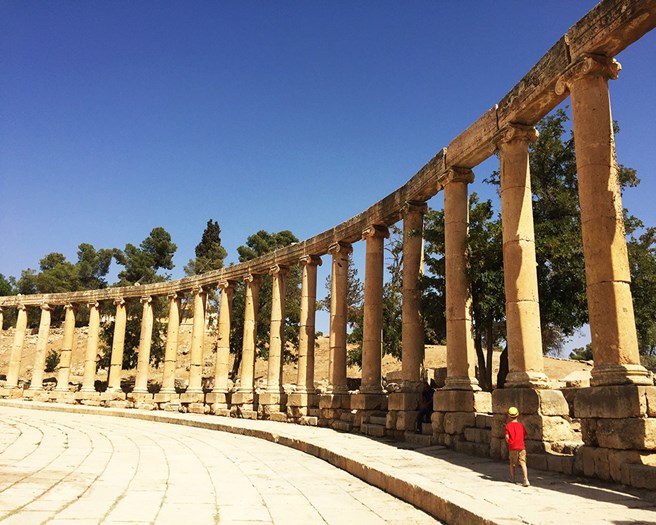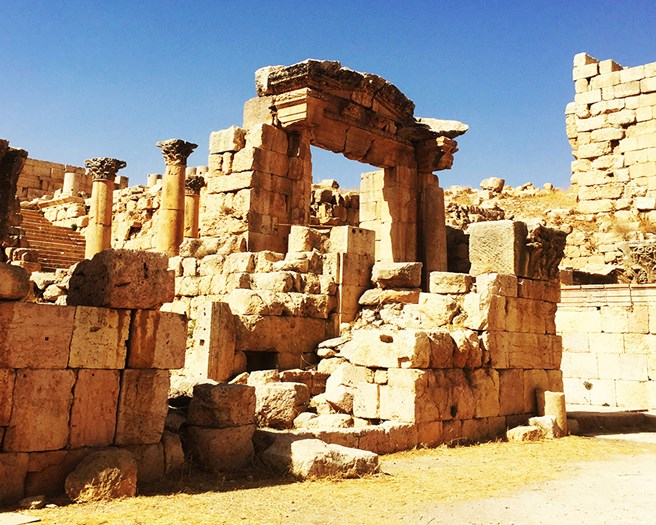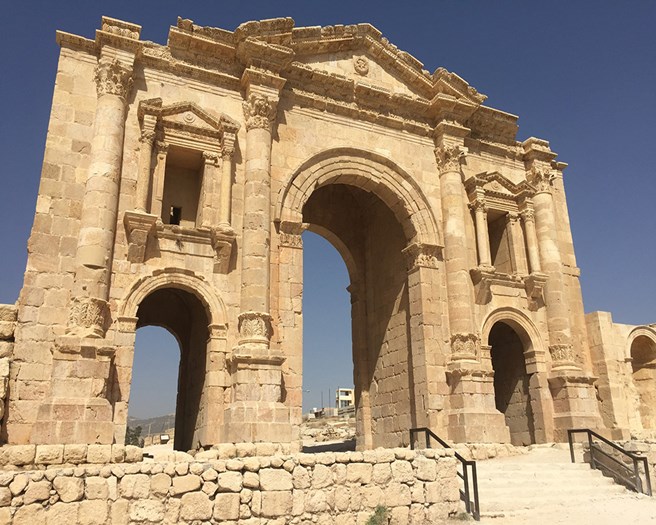JERASH, JORDAN - When I visited Jordan, I had no idea I would find myself walking down the Cardo Maximus, a colonnaded street in Gerasa, a once bustling Roman city and an important part of the Roman Decapolis. But that is exactly what I found when I visited Jerash, just a 45-minute drive from Amman, the capital city of Jordan.
Jerash is Jordan’s second most popular tourist site (after Petra) and is the second best preserved Roman city outside of Rome. Its amazing preservation is due, in part, to the Middle East’s dry air and because a mudslide covered the site until its discovery in 1806 by Ulrich Jasper Seetzen, a German scholar and explorer. Major excavations began in 1878 by Circassians from Russia, who had moved into the area and quickly discovered that an important archaeological site lay beneath them. They unearthed a collection of arches, two amphitheatres, the colonnaded streets and a hippodrome, where chariot races saw brave horsemen race around the stadium.
When I arrived in Jerash, the first thing I saw was the Arch of Hadrian, a 13-metre-high triple arch built to commemorate the visit of the Roman Emperor Hadrian in 129 CE. I stood as far back as I could to take in the massive structure. Its state of preservation and reconstruction are immaculate. It was comprised of a main central arch and two smaller arches flanking each side. I stopped under the arch for a moment, imagining the huge wooden doors that once stood under the arch and gazed at the now barren city in front of me.

Above: Walking among ancient Roman columns.
After a drink of water under the shade of Hadrian’s Arch, I continued to the Forum Cardo. The oval forum was discovered in 1970 by Jordanian army forces, who were setting up tents in what was an ideal camp site — a flat location in an area full of hills.
It is an impressive sight not only because of its sheer size, but because of its design of limestone blocks — which get larger as you move away from the centre of the oval — and its 56 Corinthian, honey-coloured columns decorated with acanthus leaves and scrolls.
This oval forum is one of Jerash’s highlights as it once served as a marketplace and was the centre of social and political life for the residents of Gerasa. Walking through the giant forum, I imagined pedlars hawking their wares, people gossiping about local news and politics and announcements being made above the bustling noise of a vibrant city.
The forum leads to the Cardo Maximus, where earthquakes have made this once flat colonnaded road a wavy surface. On either side of the street, Ionic columns line the roadway. While I walked its length to the city’s North Gate, close examination shows the 2,000-year-old marks made by wheeled carts.
The Cardo Maximus was built in the 1st century and included holes that allowed for underground drainage. The level of sophistication in these 2,000-year-old structures still amazes me. It is intersected by the east-west running Decumanus (Cardos run north-south), noted by the remains of four towers, one on each corner of the intersection.
Continuing along the Cardo Maximus, stalls on either side of the street were once full of merchandise as shopkeepers supplied this once bustling city with goods.


Above: The past comes alive thanks to the remarkable ruins that dominate Jerash.
Plenty of Roman structures lie on either side of the street, from the cathedral entrance, western baths and the nymphaeum, the main fountain in Jerash.
The nymphaeum is a huge two-storey structure, which once had a half-dome roof. During its glory days, water cascaded from the heads of seven carved lions. It gives clues to what the ancient city looked like, as some original plaster and paint still remain on the upper level of the fountain. The entire city was once ornately painted, yet only small clues remain to show how it once looked.
When I emerged to see the south theatre, its sheer size took my breath away. Standing on the edge of an ancient crumbling theatre is a little terrifying, but I carefully climbed up to the top, taking in a view from the best seats in the house. Built between 81 and 96 CE, this ancient theatre once seated over 5,000 spectators.
Wandering to the highest point of Jerash, I gazed over at Zeus’ Temple with the intricate and delicate Greek carvings that make up the once beautiful building. Fifteen churches also lie in the historic site of Jerash.
When Christianly became the official religion in the Roman Empire, churches and cathedrals became the priority and cities competed to build the most elaborate structures. Mosaics from these churches can still be seen in Jerash today.
Gerasa was a bustling Roman city and its importance was in part due to the rich soil in the region, which provided an ideal climate for growing fruits and vegetables. In the 3rd century CE, its population mushroomed to between 15,000 to 20,000. The city is also home to a second temple, the Artemis Temple, a second theatre, and two Roman baths.
An earthquake in 747 CE started the idecline of the city and it eventually became deserted for many centuries, with only brief occupation by the Crusaders in the 12th century.
Despite Jerash’s grandeur, it is not a UNESCO World Heritage Site and thus is unprotected. The reason? The inhabitants of modern-day Jerash have built their homes and their businesses within the ancient city walls and thus it’s impossible to move a working city out of an ancient Roman site.
While the hot Middle East sun beat down on my shoulders as I walked away from the oval forum, I could still imagine the Roman inhabitants of Gerasa filling the streets and the forums.
I am glad that I did not rush to Petra and skip Jerash. It is well worth a visit and I feel now that I understand so much more about the Roman Empire without having to compete with the thousands of tourists who visit Rome.
Information
Jerash is located 50 kilometres north of Amman. / Entrance to Jerash costs JD8 and local guides are JD20 / A taxi from Amman to Jerash costs around JD25 / Expect to spend 3-4 hours at the site. / Bring plenty of water as there is little shade. / Snack shops and toilets are available on site.